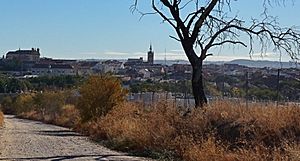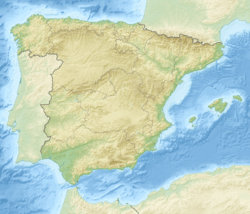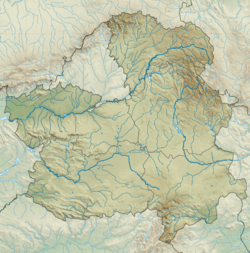Illescas, Toledo facts for kids
Quick facts for kids
Illescas
|
|||
|---|---|---|---|
 |
|||
|
|||
| Country | Spain | ||
| Autonomous community | Castilla–La Mancha | ||
| Province | Toledo | ||
| Area | |||
| • Total | 56.75 km2 (21.91 sq mi) | ||
| Elevation | 583 m (1,913 ft) | ||
| Population
(2018)
|
|||
| • Total | 28,064 | ||
| • Density | 494.52/km2 (1,280.80/sq mi) | ||
| Time zone | UTC+1 (CET) | ||
| • Summer (DST) | UTC+2 (CEST) | ||
Illescas is a town and municipality in Spain. It is located in the province of Toledo, which is part of the Castilla–La Mancha region. The town covers an area of about 56.75 square kilometers. As of January 1, 2020, Illescas had a population of 30,229 people. This makes it the third most populated town in its province. It is part of a traditional area called La Sagra.
Contents
What's in a Name?
The name of Illescas has changed over time. In the Middle Ages, it was first called Elesches. Later, people used names like Ilesches, Ilescas, Ailescas, Hilesques, Ylesches, and Hylesques.
Some people think the name might come from an old word, Egelesta, mentioned in ancient writings. This word could be linked to the Iberian-Basque word 'egi-', meaning "hill line" or "hillside." Other experts believe Illescas might be related to a very old word, 'il', which means "city."
A Look at Illescas's Past
Long ago, there was an ancient settlement called Carpetani in the area where Illescas is now. This site is known as El Cerrón.
In the 12th century, King Alfonso VII gained control of Illescas. In 1154, he gave the town a special document called a population charter. This charter gave certain rights and benefits to the settlers who came from Gascony. Later, in 1176, Illescas became part of the lands owned by the Archbishop of Toledo. This meant the church had a lot of power over the town.
In the 14th century, the people of Illescas tried to gain more freedom from the church. However, the king decided in 1329 that the church would keep its control. But the king still managed the areas where Muslim and Jewish people lived. In 1441, the town was attacked and robbed.
By the 15th century, Illescas was a town surrounded by walls. It had an important marketplace where people bought and sold goods. The town also collected a tax from people entering through its gates, but people from Madrid did not have to pay this tax. In May 1575, Illescas became a "royal demesne" town. This meant it was directly under the control of the king, not the church.
In 1876, Illescas got a railway line, which helped it connect with other places. The town's population grew steadily throughout the 20th century. In the early 21st century, the population grew very quickly, almost tripling. Because of its good location, transportation links, and available land, Illescas became a major center for logistics (moving and storing goods) in Spain.
Where is Illescas?
Illescas is located on a flat area between the cities of Madrid and Toledo. It is part of the La Sagra region.
To the north, it shares borders with the towns of Casarrubuelos, Cubas de la Sagra, Torrejón de la Calzada, and Torrejón de Velasco. To the east, it borders Yeles. To the south, it borders Numancia de la Sagra. To the west, Illescas borders Cedillo del Condado, El Viso de San Juan, Ugena, and Carranque.
Important Places to See
Illescas has several interesting historical buildings and sites.
Arco de Ugena
The Arco de Ugena is a remaining part of an old wooden gate called Puerta de Ugena. This gate was built in the Mudéjar style, which mixes Christian and Muslim art. The town used to have five such gates in its wall, but the Arco de Ugena is the only one left. People believe it was built around the 11th century.
Convento de la Concepción de la Madre de Dios
This convent was built in 1514 by a very important person, Cardinal Cisneros. The first leader of the convent, called the mother superior, was Cardinal Cisneros's cousin.
Hospital Nuestra Señora de la Caridad
This hospital was built between the 16th and 17th centuries. It is a historic building that served the community for many years.
Santuario de Nuestra Señora de la Caridad
This sanctuary was built in 1500. It is famous because it holds five paintings by the well-known artist El Greco. These paintings include Saint Ildefonsus and four others made for its main altar: Charity, Coronation of the Virgin, Nativity, and Annunciation.
Iglesia Parroquial and Torre Mudéjar
The parish church and its Mudéjar Tower are also important landmarks. In 1920, this church and tower were declared a national monument.
Calle Real
Calle Real is the main street in Illescas. It is a busy street with many buildings and people.
Plaza de las Cadenas
This square is located in front of the Iglesia de la Caridad. It is a public space where people can gather.
Olmo del Milagro
The Olmo del Milagro is a very old elm tree. It is believed to be about 500 years old.
See also
 In Spanish: Illescas (Toledo) para niños
In Spanish: Illescas (Toledo) para niños





